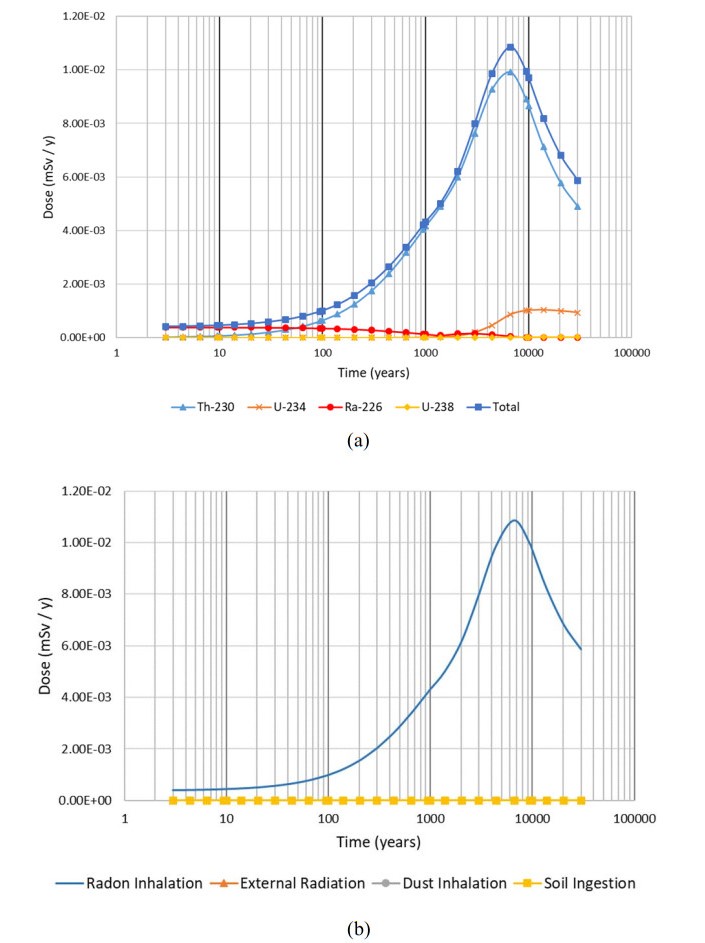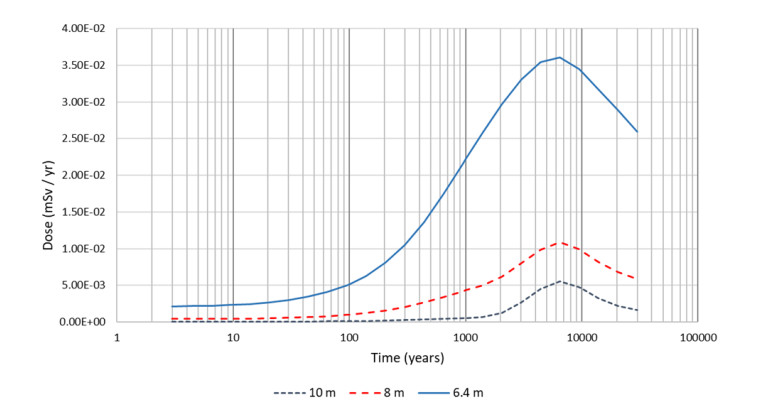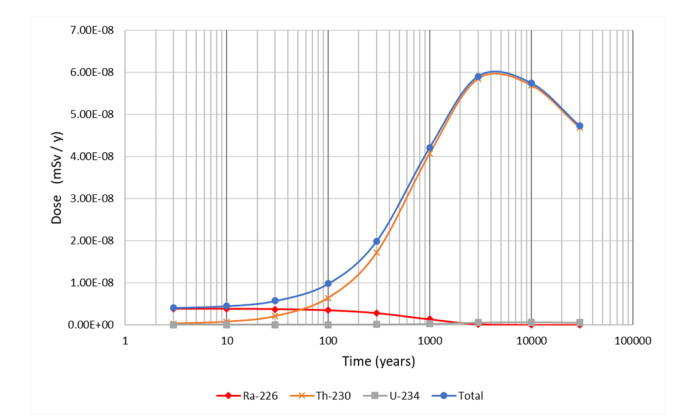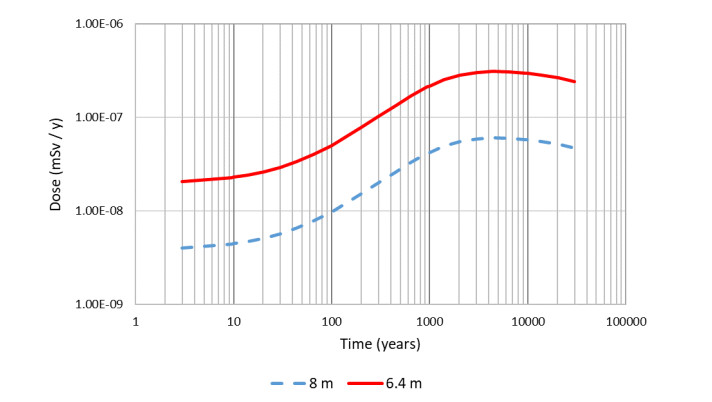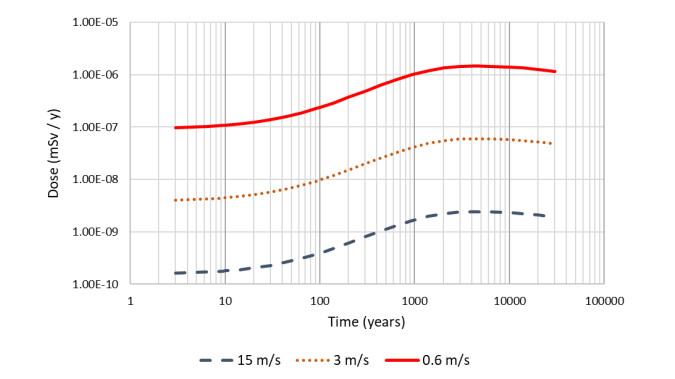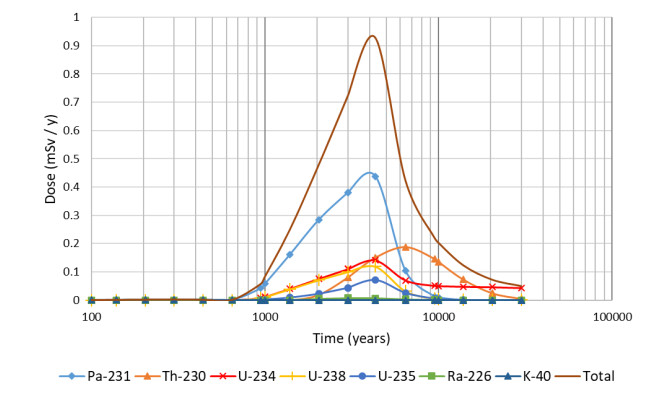1.
Introduction
Industrial processes such as oil and gas production, fertilizers production, extraction and processing of metal ores produce large quantities of Naturally Occurring Radioactive Material, NORMs, and can cause NORMs to be concentrated at levels above natural background, giving rise to by-product waste streams referred to as Technologically Enhanced NORMs or TENORMs.
Minimization of risks to public and environment is a key issue for the disposal and management of NORM and TENORM wastes. In this regard, adequate protection of the human health and the environment must be guaranteed according to assessment of dose limits to workers and population, by minimizing doses on the basis of the ALARA principle "As Low As Reasonably Achievable" [1,2].
In general, for the disposal of residues contaminated by NORM, the long-term acceptability and safety of the proposed method of disposal must be demonstrated. To this end, a radiological risk assessment is required for workers and the general public in order to demonstrate that the proposed method of disposal meets all the requirements of existing legislation and regulations.
Among the methods of disposal of processing residues containing TENORM, subsurface burial in hazardous or non-hazardous waste landfills is presented in the literature as a possible and advantageous option for the disposal of solid type residues [3,4,5,6,7,8,9,10]. In addition, Near Surface Disposal (NSD) takes advantage and justification from the numerous studies carried out on low-activity radioactive waste originated from nuclear activities which, unlike NORMs, are real radioactive waste and fall within the most stringent radiation protection legislation. [11,12,13].
Among the computational codes that have been adopted in literature to assess the dose to workers, public and environment for the cases of NORMs/TENORMs landfills and near surface radioactive repositories there are the RESRAD family codes [3,4,5,8,9,10,11,13,14,15,16,17,18], HELP code [4], MicroShield, SWIFT II and TSD dose codes [4,5].
The present work is aimed at developing a methodology for a preliminary radiation protection assessment regarding the final confinement process in a landfill of industrial processing residues contaminated by TENORMs. The hypothetical case study here considered, which takes inspiration from a real case study, regards TENORMs originated from phosphoric acid industry activities related to the production of fertilizers. For this kind of case the sources of TENORMs radioactivity are the isotopes U-238, U-235 and Th-232 and their progeny, which are naturally present in the phosphate rocks from which phosphates are extracted. The management and disposal of TENORMs has been modelled to evaluate the potential dose to workers and public via TSD dose for the workers involved in the positioning activities and via RESRAD on-site for workers and population after the closure of the disposal site.
The dose assessments have been carried out on the basis of data inspired from a real case design stratigraphy and the related various geometric, hydraulic, hydrogeological and chemical-physical parameters design.
The scenarios here considered and evaluated concern the workers involved in the management and operation of the site during its production life cycle (unloading of big-bags containing wastes, positioning and covering). At the end of the production life cycle of the landfill, after the total covering of the waste and the closure of the site, some possible scenarios for workers and individuals of the population have been considered. In particular, also the possible scenarios concerning both workers in charge of site management and surveillance activities and individuals from the population who may, for example, spend periods of time in areas above the landfill have been considered. Results are expressed in terms of total effective dose equivalent (TEDE) to the worker or to members of the public who for various reasons occupy the land above the landfill or drink water extracted from a well which is hypothetically positioned at the boundary of the site. The dose is evaluated for a period up to 30000 years after the end of the production cycle of the landfill site.
Sensitivity analyses have been conducted to evaluate the impact of characteristic parameters such as the thickness of the coverage layer and the wind speed on potential risk for workers and population.
The paper is organized as follows: in Section 2, the adopted methodology is described, Section 3, reports the features of the proposed case study and the scenarios taken into consideration for the estimation of doses to workers and population, Section 4 presents the results in details and Section 5 summarizes the main conclusions.
2.
Methodology
The criteria, methods and parameters that have been considered to develop a methodology for a preliminary assessment of the radiological impact to workers and to the population due to confinement of TENORMs in landfills once the hesitation activities of the various waste have been completed are described in the following.
In order to be able to carry out a dose assessment it is necessary, before any consideration, to identify the critical reference groups and related exposure scenarios.
2.1. Critical groups
During the production life cycle of the site workers are involved in the management and operation of the site by unloading, positioning and covering big-bags containing waste. Then, for a certain number of years, once its production life is over, the site may be frequented by workers in charge of custody, maintenance and control. In the long term, the site could finally be released and used as a green area and, in this case, the individuals who occupy the landfill land could be individuals of the population as occasional visitors. In addition, after the release of the site, it is assumed possible that drinking water will be withdrawn from a well which is positioned at the boundary of the site.
2.2. Exposure Scenarios
Taking into account the production life cycle of the site and the possible future destinations of the contaminated site, four possible kinds of scenarios have been identified:
i) the case of a critical group of workers that are involved in the management and operation of the site by unloading waste big bags from vehicle, placing in landfill and covering them;
ii) the case of a critical group of workers assigned to site surveillance and management activities once the productive life cycle of the landfill is ended who remains on the site during working hours and carries out his work both outdoors and sheltered in a building located on the ground above the landfill in rooms which are assumed conservatively to have a poor air exchange;
iii) the case of a critical group of the population (for example occasional visitors) who, in the unlikely event of release of the site and its use as public park, could spend for recreational purposes even prolonged periods of time in areas above the sub-surface landfill for a maximum time corresponding to that of the workers in charge of the site;
iv) the unlikely case of a critical group of the population who, after the release of the site, can live in the neighbourhood of the landfill and withdraw water for drinking purposes from a well at the border of the landfill.
2.3. Calculation method and strategy
The adopted analytical and computational tools are the following:
• Formulas from Radiation Protection 122, Practical Use of the Concepts of Clearance and Exemption - Part II, have been adopted to evaluate internal doses to workers due to inhalation of re-suspended particles and ingestion of particulate [19].
• TSD Dose code, developed by Argonne National Laboratory, has been adopted to estimate radiological doses to workers that are involved in waste placement activities [20].
• RESRAD on-site code, developed by Environmental Science Division, Argonne National Laboratory, Department of Energy (DOE), has been adopted for the evaluation of the potential radiation dose to individuals who spend time on the primary contaminated area (on-site) [21,22].
The performed calculations with RESRAD consider the following radiation pathways: external radiation, ingestion and inhalation of dust and inhalation of radon gas. Characteristic parameters which constitute the input data are:
• chemical-physical-mechanical parameters characteristic of the waste;
• radionuclide inventory;
• parameters relating to the geometry of the system and its stratigraphic analysis;
• identification of impermeable, unsaturated and saturated soils;
• hydrogeological, physical, hydraulic and meteorological parameters of the site and the soil;
• distribution coefficients of radionuclides;
• parameters related to radon emanation.
Considering the possible scenarios for the population, and given their possible effective implementation in very remote times compared to the moment of closure of the landfill at the end of its production cycle, the assessments of the dose is extended up to a time horizon of 30000 years, in order to be able to evaluate the long-term radiological relevance for the population and the actual feasibility of the considered disposal method. The study area is located at the center of a sediment alluvial infill, overlaid on a limestone bedrock which on the western flank leans against a filladic basement. Alluvial sediments extend transversally for about 2 km and longitudinally for about 6 km downhill, with a slight slope, from the site to the seacoast. There are no waterways nearby except for ephemeral streams along the contact between the limestone and the alluvial infill. Moreover, historical and modern instrumental data show that the seismic hazard is absolutely negligible. Therefore, it can be reasonably assumed that the study area should not be strongly affected by processes which could significantly alter the subsurface even for relatively long times, such as for example some ten thousand of years.
Sensitivity analyses have been conducted to evaluate the impact of relevant parameters on potential dose. The results are expressed in terms of dose to the worker or to members of the public who for various reasons occupy the land above the landfill. The doses are evaluated and compared, over time, according to different situations such as i) soil occupation conditions, ii) weather-climatic conditions iii) distance from the contaminated waste layer i.e. thickness of the coverage layer. In addition, the different contributions of the radionuclides to the total dose are analysed, in order to be able to identify the most responsible radionuclides, the related contamination pathways and the possible measures of mitigation of the evaluated doses.
3.
Case study
The proposed case study concerns the disposal in a landfill of TENORMs generated from the remediation activities of a dismissed industrial contaminated site of production of phosphoric acid. The sources of TENORMs radioactivity are the isotopes U-238, U-235, Th-232 and K-40, and their progeny, which are naturally present in the phosphate rocks from which phosphates are extracted. The waste is supposed to consist of phosphate sludges, soil mixed with phosphate sludges and materials from the demolition of buildings inside a contaminated area.
3.1. Source term
The disposal area is supposed to have a cylindrical geometry with a base of 5000 m2 and 6 m height, with a total volume of 30000 m3. The TENORM wastes are assumed to be confined into big-bags of 1 m3. The wastes are formed by phosphate sludges mixed with soil and materials from the demolition of buildings inside a contaminated area. A realistic average density value of 1300 kg/m3 is adopted by making a weighted average of the different kinds of waste component that exhibit different densities values. The total mass is 39000 tons.
On the basis of typical radionuclide inventory of phosphate sludges, an average inventory is assumed for all the considered materials, i.e. phosphate sludges, soil mixed with phosphate sludges and materials deriving from demolitions although the latter may not be contaminated by TENORMs in the bulk but only on the surface, with a probable content of NORMs not far from the environmental background. An alteration of the secular equilibrium of the decay chains of the natural series is assumed due to industrial activities of extraction and separation. The adopted inventory is reported in Table 1. The radionuclide concentrations in the primary contaminated area are assumed to be conservatively uniform, even if separating layers of non-contaminated materials are often foreseen.
For the placement of the TENORMs in the landfill, a covering layer is envisaged with approximately 8 meters of thickness made of material similar to soil and an underlying layer of 2.6 m consisting of two layers of gravel and bentonite (artificial geologic barrier) respectively. For this calculation, to be conservative, no covering layers of clay or bentonite have been supposed. Table 2 reports the assumed characteristic parameters of the stratigraphy of the landfill site considered for the calculation. The various layers are numbered progressively starting from the ground level up to the confined aquifer. Underground parameters have been assumed uniform in space and constant over time. The hydraulic gradient of the pressurized aquifer is assumed 0.02. The water balance recharge terms adopted are: rainfall 0.5 m/year and overhead irrigation 0.3 m/year. These are conservative assumptions due to the fact that the landfill is supposed not equipped with a low permeability membrane on top. However, the erosion rate of the cover and the contaminated zone are supposed negligible and therefore set to 10-9 m/y supposing that the integrity of the landfill cap is maintained into the future. For the parameters other than the ones reported here, default values of the RESRAD on-side code have been adopted.
3.2. Exposure Scenarios
The exposure scenarios adopted for the radiation protection assessments for workers and for the population due to the disposal of TENORMs in sub-surface landfills are divided into two main groups: A) Dose Assessment for work activities during the landfill production life cycle and B) Dose assessments for workers and the population once the productive life cycle of the landfill is ended.
The scenarios are listed in the following.
A.Dose assessments for work activities during the landfill production life cycle.
• Scenario 1A: Worker in charge of unloading TENORM big bags from vehicle in the landfill. The worker is supposed to be at close distance from the big bags. For the calculation of the dose from external radiation, performed with TSD dose, it has been conservatively assumed that the operator is in contact with the big bags that make up the full load of the vehicle, i.e. 20 big bags.
• Scenario 2A: Worker in charge of placing TENORM big bags in the landfill. For the calculation of the dose from external radiation, performed with TSD dose, it was conservatively assumed that the operator is exposed, even during the handling phases of a single big bag, to the radiation coming from a front of 3200 big bags already positioned in the landfill, on two levels each, consisting each one of 40 rows of 40 big bags. The average distance between the waste and the worker is assumed equal to 2 meters, considering that the worker is operating from a lifter.
• Scenario 3A: Worker in charge of covering TENORM big bags in the landfill. It is assumed conservatively that the operator on a mechanical shovel operate at a distance of 2 meters above a layer of two levels of big bags with a volume of 3200 m3.
For scenarios 1A, 2A and 3A, external and internal dose rates have been evaluated with TSD dose.
B.Dose assessments for workers and the population once the productive life cycle of the landfill has ended.
Under the hypothesis that it is possible to continue to carry out working activities above the covering layers that isolate the total volume of TENORM landfill once its productive life cycle has ended, two possible scenarios, one indoor and the other outdoor, have been considered with a 30000-year time horizon. In addition, also the unlikely event of extraction of water for drinking purposes from a well at the border of the landfill has been considered.
• Scenario 1B - Indoor: worker who carries out his activity in a closed environment inside a building built on the ground above the coverage layer at the centre of the area where the TENORM wastes are confined.
• Scenario 2B-Outdoor: worker or individual of the population who carries out outdoor activities on the ground above the coverage layer at the centre of the area where the TENORM wastes are confined.
• Scenario 3B - Ingestion of drinking water: individual of the population that drinks water extracted from a well at the border of the landfill.
For both scenarios 1B and 2B the following exposure pathways have been evaluated: i) external radiation; ii) inhalation and ingestion of particulates; iii) inhalation of radon gas. For both case studies, the exposure time was considered equal to 2200 hours/year. Table 3 reports the assumed characteristic parameters for the scenarios 1B and 2B. For the parameters other than the ones reported, default values of the RESRAD on-side code have been assumed. Table 4 reports the partition coefficient default values of RESRAD assumed for all the materials.
4.
Results and discussion
Results are expressed in terms of TEDE to the workers or to members of the public who for various reasons occupy the land above the TENORM deposit in the landfill during the operational activities and once the productive life cycle of the landfill has ended.
For the dose assessments once the productive life cycle of the landfill has ended, the doses are evaluated and compared over time, with a time horizon of 30000 years, according to different situations such as i) soil occupation conditions, ii) weather-climatic conditions iii) distance from the contaminated waste layer. In addition, the different contributions that each radionuclide makes to the calculated total dose are deduced, so as to identify the most responsible radionuclides, the consequent contamination pathways and the possible ways of mitigation of the evaluated irradiation.
4.1. Results: Scenarios 1A, 2A and 3A
Table 5 reports the external dose rates evaluated with TSD dose and the estimates of the internal dose rates (inhalation and ingestion of particulate) for scenarios 1A, 2A and 3A. Internal dose rates have been evaluated according to the RP 122 formulas (par 5.4.1 Inhalation of re-suspended particles and par 5.5.1 Direct ingestion of material) assuming 10 µg/m3 for the particulate re-suspended in air and 0.05 mg/h as ingestion rate of particulate suspended in air. The estimates have been obtained with and without the use of Personal Protective Equipment (PPE) such as masks, gloves and suits.From the analysis of the results obtained with TSD dose for the workers involved during the production life cycle of the landfill (unloading, placing and covering the big bags) it is clear that the total dose rate is predominantly due to exposure from external radiation and that the most critical scenarios are those relating to the workers unloading and covering the big bags containing TENORMs. Even assuming, in an extremely conservative way, that these activities are carried out up to 2200 hours per year, an annual dose of approximately 0.1 mSv would be involved; the activity concerning the placement of TENORMs in landfills, on the other hand, would involve an annual dose lower of 1 order of magnitude, i.e. of approximately 0.02 mSv. The dose assessments for the case under consideration are therefore an order of magnitude lower than the limits set for exposed category B workers. Being the majority of the total dose resulting from external exposure, the use of PPE cannot be considered as a measure of mitigation of the absorbed dose.
4.2. Scenario 1B: worker indoor
Figure 1 shows the trend of the TEDE and the dose contributions of the individual radionuclides and their progeny to the worker who carries out his activity inside a building located above the landfill. The total annual dose is about 10-3 mSv/year during the first 100 years and increases to about 10-2 mSv/year during the following 7000 years. However, these values remain below the annual dose limit for unexposed workers and individuals of the population. The calculated dose is essentially attributable to the inhalation of radon gas which diffuses vertically through the covering layer, permeates the foundations of the building where the worker is located and accumulates in the closed environment characterized by a modest change of air.
No significant contributions to the total dose were found due to external irradiation or inhalation and ingestion of particulate matter. This is to be attributed to the shielding and insulation action exerted by the 8 meters of coverage. The influence of the thickness of the coverage on radon diffusion process has been analyzed considering a possible increase of the thickness up to a maximum of 10 meters. As shown in Figure 2, in correspondence with an increase of the thickness of the cover from 8 to 10 meters, the total dose decreases by half an order of magnitude. Therefore, for a general case, the importance of maintaining an adequate thickness of the cover is emphasized for the purpose of reducing of orders of magnitude the annual dose due to the inhalation of radon in a closed environment. It is clear that this scenario represents an unlikely situation which is the construction of permanently occupied buildings on top of the landfill. If this were to happen, however, it should be noted that the total annual dose could simply be reduced by orders of magnitude through an increase in the rate of air exchanges.
4.3. Scenario 2B Outdoor: worker or individual of the population
Figure 3 shows the trend of the TEDE absorbed by the worker or individual of population who carries out its activity outside and the dose contributions due to each radionuclide and its progeny. The total annual dose remains widely below 10-7 mSv/year over 30000 years and therefore is many orders of magnitude lower than the annual dose limit for the population. Again, the calculated dose is essentially attributable to the inhalation of radon gas that diffuses up through the cover layer gradually accumulating in the layer of air above the ground level until it reaches the atmosphere. The trend over time of the total annual dose is correlated with the concentration of radon in the TENORM. The production of radon in TENORMs is governed by the joint effect of the two following processes: i) production of Rn-222 due to the decay of Ra-226, this dose contribution is represented in Figure 3 by the curve corresponding to Ra-226 and ii) production of Rn-222 due to the decay of Th-230 in Ra-226 and of the latter in Rn-222. This dose contribution is represented in Figure 3 by the curve corresponding to Th-230. No significant contributions to the total dose were found due to external irradiation and inhalation and ingestion of particulate. This is to be attributed to the shielding and insulation action exerted by the coverage layer.
Given the considerable shielding action of the covering layer overlying the contaminated volume, the effect of its thickness has been evaluated for the case of outdoor activities also. The influence of the thickness of the cover on the radon diffusion process has been analyzed considering a possible reduction in the thickness of the coverage down to 6.4 m. As shown in Figure 4, in correspondence with a reduction in the thickness of the cover from 8 to 6.4 meters, an increase in the total dose of about 1 order of magnitude is observed, which however remains in the worst case many orders of magnitude below the dose limit per year for the population or for non-exposed workers.
Similar studies of literature also underline the importance of the thickness of the coverage both for external and internal radiation pathways [3,8,9,13,17].
Radon rising through the cover layer reaches the air layer above the ground and is dispersed into the atmosphere more or less easily depending on the wind conditions. As shown in Figure 5, the total dose can increase by an order of magnitude in correspondence with a decrease in wind speed from 3 to 0.6 m/s, while, as wind speed increases, a reduction in the total dose can be observed. The total dose results in any case less than 10-5 mSv/year even in the most concerning conditions of almost total absence of wind.
4.4. Scenario 3B - Ingestion of drinking water: individual of the population that drinks water extracted from a well at the border of the landfill.
Figure 6 shows the trend of the total dose hypothetically absorbed by ingestion by an individual of the population that drinks water extracted from a well at the border of the landfill and the dose contributions due to individual radionuclides. In this case the total annual dose remains widely below 0.1 mSv/year over the first 1000 years and then it increases to values lower than 1 mSv/year, reaching the maximum value at about 4000 years after the closure of the site. In this case the calculated dose is mainly attributable to the Pa-231, Th-230, U-234, U-238 and U-235 and their daughter products. This result indicates that even if the presence of impermeable strata underlying the disposal may delay the leakage of radionuclides from the primary contaminated area to the underground water system it cannot be excluded that some releases can take place far ahead in time. In this regard, it must be pointed out that in the present study it has not been considered, for conservative purposes, the presence of impermeable cover above the primary contaminated area which would contribute to delay even more the arrival time of the leachates to the underground water system.
Given the obtained result for this scenario, as a general recommendation, it should be considered a good practice to adopt time horizons far beyond the 1000 years that are often adopted in dose assessment for NORMs and TENORMs disposals and yet it is also recommended not to limit to radon exposure but to consider also the behaviour in underground water systems of its parent radionuclides. For what regards the partition coefficient values, this preliminary analysis was limited to assuming the default RESRAD values for the Kd of the inventory radionuclides to be the same for all soils and making sensitivity analyses to verify that partition coefficient values of all the radionuclides of concern were the most conservative ones, which proved to be true. A more accurate analysis should include a sensitivity analysis with respect to all the partition coefficients values for all the radionuclides and in the different soils.
5.
Conclusions
The present study has been aimed at developing a methodology to preliminary assess the potential health risks associated with disposing of phosphate industry TENORM wastes in a landfill. Different possible scenarios have been considered. The doses to workers and to the public on-site due to a disposal of TENORMs, mainly constituted by phosphate sludges originated from phosphoric acid production, have been estimated by the use of formulas and by the TSD Dose and the RESRAD on-site codes both during the production life cycle of the site and once it ended. Sensitivity analyses to evaluate the impact of key parameters, including partition coefficient values of all the radionuclides of concern, have been performed and only the parameters, such the coverage thickness and wind velocity, that were more sensitive than others on potential risk for workers and public have been discussed.
Summarizing the results that can be extended to similar case studies involving similar inventory-footprints, it can be stated that:
• from the analysis of the results obtained for the workers during the production life cycle of the landfill it has emerged that the total dose is predominantly due to exposure from external radiation and that the most critical scenarios are those relating to the workers unloading and covering the big bags containing TENORMs. Being the majority of the total dose resulting from external exposure, the use of PPE cannot be considered as a measure of mitigation of the absorbed dose.
• from the analyses of the results regarding doses to workers and individuals indoor and outdoor once the life cycle of the site is over, it has been found that the calculated dose is essentially attributable to the inhalation of radon gas which diffuses vertically from the primary contaminated area through the covering layer. As a general observation it must be emphasized the importance of adopting an adequate thickness of the coverage layer with results in a reduction of orders of magnitude of the dose due to the inhalation of radon indoor and outdoor. The increase of the thickness of the coverage can be therefore adopted as a measure of mitigation of the dose. However, it should be noted that the dose in closed environments could also simply be reduced by orders of magnitude through an increase in the rate of air exchanges.
• from the analyses of the TEDE behaviour along time, especially for what regards the case of ingestion of drinking water, it is recommended as a good practice to consider a time horizon far beyond the 1000 years that are often adopted in dose assessment for NORMs and TENORMs disposals and yet it is advisable not to limit dose assessment due to radon exposure of on-site individuals but to investigate also, over adequate time horizons, the migration in underground water systems of its parent radionuclides and related exposure pathways.









 DownLoad:
DownLoad:
